The Flight to Egypt
This amazing event was one of the events mentioned by the inspiration of the Holy Spirit in the second chapter of the Gospel of St. Matthew the Apostle, to be an event witnessing the greatness of the mystery of the incarnate God’s plan.The event of the Holy Family’s flight to Egypt was linked to the incident of killing the children of Bethlehem, as both events were due to Herod’s wrath against the child Jesus, after he learned from the Magi - who shook the whole city of Jerusalem upon hearing their news - about the details of their journey and the reason for their coming. This made Herod fear for his kingdom from this newborn, so he harbored evil for Jesus, and sought to get rid of the child in various ways and Herod became a tool in the hands of Satan, carrying out his aims. The Gospel tells us that Herod agreed with the Magi that when they find the child, they would tell him where he was to go and worship Him, but they did not comply with his command and returned to their country by another path as it was revealed to them in a dream, after they found the child and worshiped Him and presented Him their gifts. Herod was enraged and ordered the killing of the children of Bethlehem and its surroundings from two years old and under... for he believed that the Child Jesus would be one of them... No wonder that the will of heaven preceded the earthly temporal order. Because the Lord, who is above time and universe, sent his angel to Joseph in a dream, saying, “Arise, and take the boy and his mother, and flee to Egypt, and be there until I tell you, because Herod is about to seek the boy to destroy him” (Matthew 2:13).
Why fleeing?
The call to flee to Egypt was not out of fear of Herod. Otherwise, the Holy Family would have gone to a land far beyond Egypt, but far be it from the Creator of creation not to find a way to escape from Herod but to flee, for He is God who is able to do everything, and if He wanted to destroy Herod, He could have destroyed him. He could have sent armies of angels and take the throne away from Herod.
But the flight to Egypt was based on His divine plan, and to teach us the human race many things. His flight from evil confirmed the truth of his incarnation and that He became a perfect human being so that no one would say that He is not human but a god (according to the interpretation of St. John Chrysostom). It is also to teach us not to resist evil, but to bear adversity and to not tire of tribulations: “If you suffer for righteousness’ sake, blessed are you” (1 Peter 3:14). The Lord did not use the miracle to fulfill His needs, but He rather made it for the benefit and service of people.
The journey of the Holy Family (the Elderly Saint Joseph the Carpenter, the Virgin Mary, the Child Jesus and Salome, who pledged to serve them all her life) to Egypt began at night, and it was a long arduous journey from the land of Palestine to Egypt, where the departure was on a beast. Added to the hardships of the journey were the hardships of exile in a strange land, where Joseph and Mary were tested, although they knew perfectly well that God could spare them the hardship of travel, but their faith, filled with love for God, yielded full obedience. This is in addition to the fact that the Holy Family did not settle in one place, but it kept moving from place to place in the Egyptian country... It was as if the words of the Lord Jesus: “the foxes have dens, and the birds of the sky have nests, but the Son of Man has nowhere to lay his head” (Matthew 8:20), which He said during his preaching applied to Him even in His childhood!
The mission of the Lord Christ, glory be to Him, was as the apostle said, “God was in Christ reconciling the world to himself” (2 Corinthians 5:19), so He sent His son to Egypt - which was the center of paganism in the world - to reconcile it, thus fulfilling the prophecy of Isaiah the prophet who said, “Behold, the Lord is riding on a swift cloud, and he will come to Egypt, and the idols of Egypt will tremble at His face, and the heart of Egypt will melt within it” (Isaiah 19:1) and to save Egypt and make its people a blessed people for Him, as it came in the prophecy that says “Blessed is my people of Egypt” (Isaiah 19:25).
Then, after the period of His stay in Egypt terminated, according to His divine purpose in the plan of salvation of mankind, He returned to Israel and thus fulfilling what was said by the Lord through Hosea the Prophet, “Out of Egypt I called my son” (Hosea 11:1), (Matthew 2:15).
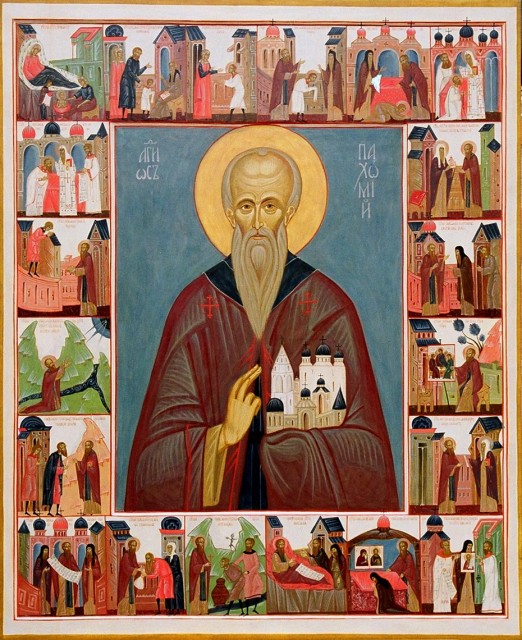
4th century
4th century
The Establishment of The Monastery
The Emergence of Monasticism in Qusqam and
The location of the Church of Our Lady in the wilderness had a share in attracting some to live and worship next to it because of its simplicity, humility and it has a unique privilege, as it was a safe and comfortable refuge for the Holy Family, in which they lived, separated from their families, in a poor and humble state, so the place became blessed by them. It was the mouth piece of those who came to worship and to be alone around the church that everyone who comes for the love of a virginal life alienated from the world and who lives in poverty and humility as the Holy Family lived, will be granted the blessing that the Lord of Glory has blessed to this place and will receive the crown of eternal life in the kingdom of heaven.It was said that some of those early hermits had a good relationship with the great Saint Anba Anthony. After the departure of Anba Pachomius, the father of Communal Monastic life, the Pachomian monasteries spread at the hands of his disciples (such as Tadros and Orsios...) in all parts of Egypt. Many other monastic groups also followed the laws of Anba Pachomius without joining the monasteries of the Pachomian communal life. Others built monasteries and drew from the Pachomian system a special system for them. The study indicates that some of the students of Anba Pachomius, or at least a group of monks of the Pachomian community, came to Qasqam in the latter half of the fourth century and participated with the residents around the church in establishing the monastery, although it is not known exactly when they came, but it happened after the departure of Anba Pachomius, the father of Communal Monastic life (346 AD).
`{`In fact, the scholars of the Pachomian communal life have unanimously agreed that Anba Pachomius, the father of communal monastic life, established only nine monasteries for monks and two monasteries for nuns, confined between Akhmim in the north and Esna in the south`}`, and the communal life was similar to the community of the early church, where everything was common between them (Acts 2:44). The basis of their physical life was focused on poverty, humility, lack of possessions and escaping from the love of possession. As for the center of the monk’s spiritual life, it was the Bible, the Eucharist, and constant prayer. It seems that the applied method of the Pachomian laws in the Qusqam monastery had the special character of what the monastery was famous for by its openness to visitors and asylum seekers asking for healing from the water of the well that Jesus blessed, and for the supplication and intercession of the Mother of God, the Virgin, Saint Mary. Voluptatem accusantium doloremque laudantium, intota rem aperiam, eaque ipsa quae ab illo inventore veritatis et quasi no architecto beatae vitae dicta sunt explicabo men enim ipsam volupt

The Holy Family in Qusqam
The recognized ecclesiastical books of the Coptic Church and the old books (trusted for their authenticity) which talked about the Holy Family unanimously agreed, and the researchers also almost unanimously agreed that the Holy Family, after it traveled from Jerusalem to Egypt and moved between several countries and villages, landed in Qusqam and the studies indicated that the foot of Mount Qusqam was, at that time, a desert inhabited by no one at all, except for the existence of an abandoned house made of mud and its roof made of palm fronds and it was located on the slope of a wide eastern plateau, and outside of it from the northern side, there was a water well.When the Holy Family resorted to this house by divine measure, they rested in it after the trouble and hardship of traveling. They stayed there for a period of time in calm and serenity living a simple life in a modest situation, managing their necessary food for sustenance with divine care. The water from the well increased in abundance and became good and sweet to drink despite its drought for a long time. Joseph the carpenter also made repairs to the house.. and at the top there was an upper room in which the Virgin Mary stayed with her beloved son. At that time, there was a cave in the mountain near this house, to which the Virgin Mary went sometimes with her beloved child.

Jossi's Story
During that time, a man called Jossi (or Joshua) or (Moses in some manuscripts) from the tribe of Judah came to them. This man had heard that Herod sent ten of his soldiers to search for the baby Jesus in Egypt. With divine guidance, this man hurried to Egypt to warn the Holy Family of this, when he miraculously reached Qusqam after suffering and hardship. He told them what Herod had commanded, and the Virgin was very upset, as were both Joseph and Salome, but the Lord God assured them that nothing would happen to them. So Jossi’s mission ended with this, and he slept in the Lord and was buried by Joseph the carpenter at the entrance to the threshold of the house (and after that the monks inherited from generation to generation that the place of Jossi’s Tomb was in the south-western side of the ancient church).The Holy Family remained in this house and rested in it until the angel of the Lord appeared to Joseph the carpenter in a dream, saying, “Get up and take the boy and his mother, and go to the land of Israel, because those who were seeking the boy's soul have died” (Matthew 2:19, 20). Before their departure, the Lord blessed this place as a holy blessing, because it was a shelter and comfort for them in their sojourn.
This great event was in the year 4 B.C. and according to the Egyptian and the Roman (Julian) calendar prevailing at that time, they arrived at Qosqam on the night of the 7th of Baramouda, corresponding to April 2nd, which was a Monday, and left during the daytime of Baba 6th, corresponding to October 3rd, which was a Wednesday, i.e. they stayed 185 days. `{`Taking into account when calculating the number of days - as that year was simple - the 7th of Baramouda and the 6th of Baba as days of stay in Qusqam`}`.
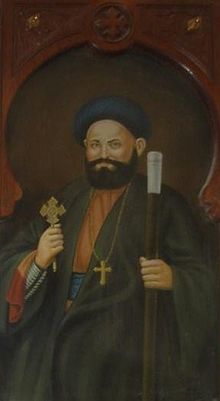
Pope Gabriel IV the 86th Patriarch
Detailed news came about this chrism in one of the old chrism books in the patriarchal library, which was written by Anba Athanasius, Bishop of Qus at that time. This patriarch cooked a greater quantity of holy chrism oil than all the patriarchs who preceded him (where the amount of chrism oil was three and a third of a quintal Ghalileon oil was one and a third of a quintal). Pope Gabriel departed on April 28, 1378 AD, and the patriarchal seat remained vacant for two months and twenty-seven days until Anba Mattaus the Great was chosen as patriarch after him.
When the Holy Family resorted to this house by divine measure, they rested in it after the trouble and hardship of traveling. They stayed there for a period of time in calm and serenity living a simple life in a modest situation, managing their necessary food for sustenance with divine care. The water from the well increased in abundance and became good and sweet to drink despite its drought for a long time. Joseph the carpenter also made repairs to the house.. and at the top there was an upper room in which the Virgin Mary stayed with her beloved son. At that time, there was a cave in the mountain near this house, to which the Virgin Mary went sometimes with her beloved child.
Popes from the Monastery of the Virgin Mary in Muharraq
About six months before the patriarchal seat became vacant, the bishops met in Cairo with the archons of the people to choose a patriarch. After research and selection, their opinion settled on choosing the abbot of Muharraq Monastery, called the monk Gabriel. He was a virtuous father and a devout worshiper, in addition to his vast knowledge and great esteem, so they presented him as a patriarch in the church of Saints Sergius and Bacchus in Alexandria in the year 1086 A.M. in the year 1370 A.D. on the glorious Feast of the Epiphana translated as the Divine Apparition, which is the feast of the Holy Baptism. During his days, the Coptic people had some rest. The holy Chrism was made during the days of his pontificate, when the bishops met under his presidency in the monastery of Abi Makar in the year 1090 A.M. (1374 A.D.).Detailed news came about this chrism in one of the old chrism books in the patriarchal library, which was written by Anba Athanasius, Bishop of Qus at that time. This patriarch cooked a greater quantity of holy chrism oil than all the patriarchs who preceded him (where the amount of chrism oil was three and a third of a quintal Ghalileon oil was one and a third of a quintal). Pope Gabriel departed on April 28, 1378 AD, and the patriarchal seat remained vacant for two months and twenty-seven days until Anba Mattaus the Great was chosen as patriarch after him.
When the Holy Family resorted to this house by divine measure, they rested in it after the trouble and hardship of traveling. They stayed there for a period of time in calm and serenity living a simple life in a modest situation, managing their necessary food for sustenance with divine care. The water from the well increased in abundance and became good and sweet to drink despite its drought for a long time. Joseph the carpenter also made repairs to the house.. and at the top there was an upper room in which the Virgin Mary stayed with her beloved son. At that time, there was a cave in the mountain near this house, to which the Virgin Mary went sometimes with her beloved child.
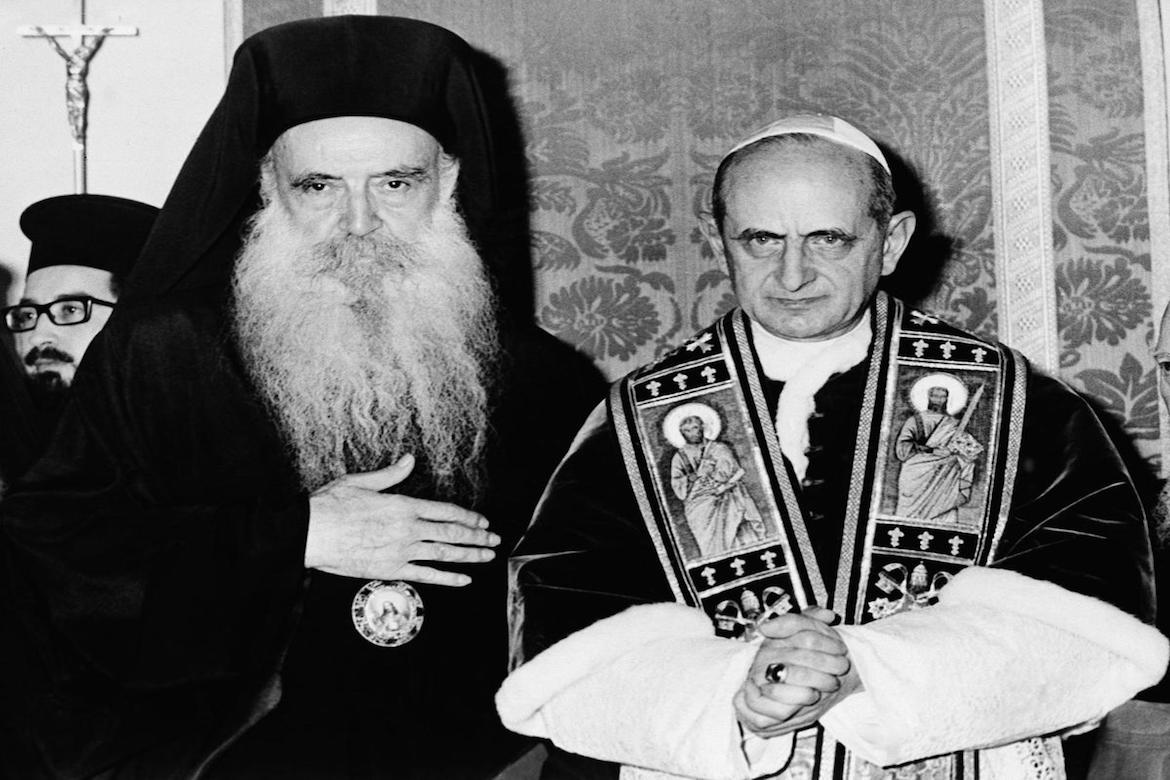
Pope Mattaus I - the Great – the 87th Patriarch - nicknamed the poor
He began to practice these works when he was young, until he reached the age of fourteen, at that time he left his father’s house and went to one of the monasteries of Upper Egypt `{`the monastery of Abi Fana in the year 1350 AD and remained there until 1354 AD - from a valuable study by Professor Nabih Kamel Daoud, on the monastery of Abi Fanam, Bishopric of Malhawy, Ansena, and Ashmounin`}` and he worked there as a shepherd as usual, and he did not wear a garment over his body, but he was content with a cloak and a rope on his waist, and despite his self-deprecation in his clothing and self-denial in this way, he was of rare courage and great strength. The shepherds who were older than him tested this father for his courage, so they send him to those villages which were spotted by Hyenas at night to rob their sheep, as they were unable to resist them. Then, when he approached them and shouted at them, they would flee from him and run away. The shepherds were astonished by the greatness of his courage and the speed of his resolution.
Popes from the Monastery of the Virgin Mary in Muharraq
This immaculate Pope was from a small town called Bani Rouh in the ancient state of Ashmunin - the center of Mallawy today in Upper Egypt - and he was raised in the town office where he memorized psalms and verses and learned to read and write. His father entrusted him since his childhood with carrying out the tasks of shepherding the sheep in his house, and God who manifest his wonders in his saints, showed in this child since his childhood amazing works in caring. When he was standing to play with the children, he would put his hand on the head of each of the children and say “Axios Axios Axios” three times. Many times, he ordained a group of them as priests and others as deacons, until his blessed mother was amazed at this and pointed to the crowd, saying: My son this must become a patriarch: foretelling that by divine inspiration.He began to practice these works when he was young, until he reached the age of fourteen, at that time he left his father’s house and went to one of the monasteries of Upper Egypt `{`the monastery of Abi Fana in the year 1350 AD and remained there until 1354 AD - from a valuable study by Professor Nabih Kamel Daoud, on the monastery of Abi Fanam, Bishopric of Malhawy, Ansena, and Ashmounin`}` and he worked there as a shepherd as usual, and he did not wear a garment over his body, but he was content with a cloak and a rope on his waist, and despite his self-deprecation in his clothing and self-denial in this way, he was of rare courage and great strength. The shepherds who were older than him tested this father for his courage, so they send him to those villages which were spotted by Hyenas at night to rob their sheep, as they were unable to resist them. Then, when he approached them and shouted at them, they would flee from him and run away. The shepherds were astonished by the greatness of his courage and the speed of his resolution.
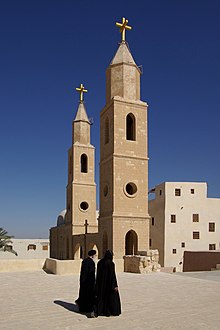
His ordination as a priest and his escape to Mount Saint Anthony in the wilderness
When Matthew the priest saw the conflict which occurred because of him, he went to Mount St. Anthony (around the year 1254 AD) and disappeared in the monastery and did not show anyone that he was a priest. And he was in his service in the church, serving as a simple deacon, as he did not want anyone to know that he was a priest. But the will of God is above all will, as a miracle occurred because of his denial of this. During the service in the church, a hand came out of the sanctuary and gave him incense three times when reading the Gospel, then it disappeared from him. When some of the elderly holy monks saw that, including Father St. Mark the Anthony, and verified it, they said that this person must become a patriarch.. When he heard these words from them, he was very sad. He rose and left the monastery and went to the city of Jerusalem. His holiness soon became famous, so he returned again to the monastery of St. Anthony.
The governor’s orders had been issued in Egypt to punish the monks in the monasteries. When the soldiers came, they arrested Father Matthew and beat Father Mark the Anthony instead of him. Then the commander wanted to take them to Egypt. On the way, they became thirsty and the commander refused to give them water. Blessed Mark prayed and raised his face to the sky, so it opened and rain fell and the valleys were filled, and they all drank, and because of the heavy rain, it became impossible to walk, so they went down to rest.
Then, a messenger from the governor informed them of their salvation and their return to the monastery.. The commander was surprised and regretted punishing them.. Father Matta did not stay in the monastery except for a short time, then he took permission from the blessed Father Mark the Anthony and went to the monastery of Muharraq around the year 1366 A.D. He had blessed works there, which were the reason for much benefit to the monastery, until he was chosen as a patriarch in the year 1378 A.D.
Popes from the Monastery of the Virgin Mary in Muharraq
He was ordained a priest when he was eighteen years old. When the news of the ordination spread and it reached the ears of his spiritual father, Archpriest Abram Al-Fani (from the monastery of Abi Fana), he immediately rose and met the bishop, objecting to his behavior, saying: How did you dare, O Father, to consecrate a young boy who is a shepherd as a priest when he was eighteen years old? The bishop convinced him that the young man deserved to be a patriarch because he knew about the conditions of this priest, who during the period of his stay with the bishop fasted two days in summer and three days in winter.When Matthew the priest saw the conflict which occurred because of him, he went to Mount St. Anthony (around the year 1254 AD) and disappeared in the monastery and did not show anyone that he was a priest. And he was in his service in the church, serving as a simple deacon, as he did not want anyone to know that he was a priest. But the will of God is above all will, as a miracle occurred because of his denial of this. During the service in the church, a hand came out of the sanctuary and gave him incense three times when reading the Gospel, then it disappeared from him. When some of the elderly holy monks saw that, including Father St. Mark the Anthony, and verified it, they said that this person must become a patriarch.. When he heard these words from them, he was very sad. He rose and left the monastery and went to the city of Jerusalem. His holiness soon became famous, so he returned again to the monastery of St. Anthony.
The governor’s orders had been issued in Egypt to punish the monks in the monasteries. When the soldiers came, they arrested Father Matthew and beat Father Mark the Anthony instead of him. Then the commander wanted to take them to Egypt. On the way, they became thirsty and the commander refused to give them water. Blessed Mark prayed and raised his face to the sky, so it opened and rain fell and the valleys were filled, and they all drank, and because of the heavy rain, it became impossible to walk, so they went down to rest.
Then, a messenger from the governor informed them of their salvation and their return to the monastery.. The commander was surprised and regretted punishing them.. Father Matta did not stay in the monastery except for a short time, then he took permission from the blessed Father Mark the Anthony and went to the monastery of Muharraq around the year 1366 A.D. He had blessed works there, which were the reason for much benefit to the monastery, until he was chosen as a patriarch in the year 1378 A.D.
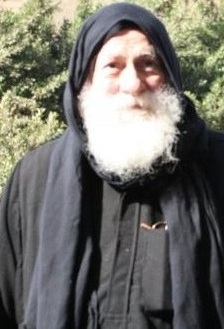
Candidacy of Priest Matta for the Patriarchate
A group of from the people then started searching among the monks for a suitable person to nominate him for the patriarchate, until their opinion settled on asking Matthew the priest to become their patriarch. However, he refused and disappeared from view and went on a boat to sail to the southern regions, except that nature opposed him by the will of God. While searching for him, a young child came by divine inspiration and he showed them to him, saying: He is hiding in the bottom of the boat. So the people hurried to him and brought him out. When he knew that he could not escape from their hands, then he urgently asked them to consult his fathers the elders on Mount St. Anthony, who advised him not to flee from what the Lord had planned for him, but to prepare himself and accept serving as a patriarch.
This father was virtuous and wise, and he did not interfere in the politics and organization of the monastery. That is why his contemporary heads of the monastery loved and respected him. This is evident from the manuscripts he wrote in the days of their presidency. And the fathers who were his contemporary heads of the monastery are... Father Abd al-Malak al-Huri, Father Boules Gabriel al-Deljawi, Father Mikhail Fam al-Aboutiji and Father Salib Wahba. He copied quite a few manuscripts in different sizes, of which we have 64 manuscripts which include books of Readings (Katmaresat), books of expositions, sacred books, and liturgical books... the most recent of which was written in 1602 A.M. (1886 A.D.).
Popes from the Monastery of the Virgin Mary in Muharraq
Pope Gabriel IV, Patriarch (86) passed away on April 28, 1378 AD, corresponding to Bashans 3 in 1094 A.M., and after that the throne became empty for about three months.A group of from the people then started searching among the monks for a suitable person to nominate him for the patriarchate, until their opinion settled on asking Matthew the priest to become their patriarch. However, he refused and disappeared from view and went on a boat to sail to the southern regions, except that nature opposed him by the will of God. While searching for him, a young child came by divine inspiration and he showed them to him, saying: He is hiding in the bottom of the boat. So the people hurried to him and brought him out. When he knew that he could not escape from their hands, then he urgently asked them to consult his fathers the elders on Mount St. Anthony, who advised him not to flee from what the Lord had planned for him, but to prepare himself and accept serving as a patriarch.
This father was virtuous and wise, and he did not interfere in the politics and organization of the monastery. That is why his contemporary heads of the monastery loved and respected him. This is evident from the manuscripts he wrote in the days of their presidency. And the fathers who were his contemporary heads of the monastery are... Father Abd al-Malak al-Huri, Father Boules Gabriel al-Deljawi, Father Mikhail Fam al-Aboutiji and Father Salib Wahba. He copied quite a few manuscripts in different sizes, of which we have 64 manuscripts which include books of Readings (Katmaresat), books of expositions, sacred books, and liturgical books... the most recent of which was written in 1602 A.M. (1886 A.D.).

The Ordination of Reverend Matta as Patriarch in the name of Mattaus I
His Virtues: In addition to the great mercy he was characterized by in helping the poor and the monks and nuns, the Pope was never arrogant or full of pride, because he possessed with mercy the virtue of humility. And if necessity called, he would work with the laborers and workers with clay pastes and flush the lavatories of the church - in which he was - with the laymen. He would carry the clay pots and he would also rise at night and follow the traces of the donkeys that were carrying crops. Despite all of this, he did not degrade his status and his prestige did not go away from him, but rather increased in glory and reverence in the eyes of people. Since he ascended the throne, he directed his attention to prayer without ceasing. When he heard the ringing of the bell he installed, he rose to pray on time while continuing to practice the virtue of fasting.
His Miracles: In addition to the talents that God gave him to expel demons and heal incurable diseases, God gave him the gift of raising the dead. It is mentioned that a man was working as a worker in an old building in the Church of the Virgin Mary in Harat Zuwaila, so he fell while working from above the scaffold to the ground and was carrying a heavy stone. When the worker fell, that stone came down on his body and broke his ribs, and he died, and his companions intended to leave him in his place and flee. When the Pope heard about this incident - as he was staying at the time in this church - he did not enable the worker's companions to escape, and rose up against them saying: Be quiet and do not say that the worker has died because he did not die, and I guarantee you from the mercies of the Lord Jesus that he is alive. So four people carried him and placed him as the Pope commanded in front of the icon of the Virgin Mary, the patron Saint of the church. Then he covered him with his ministry garment for about three hours of the day until the ninth hour, and he asked for a little hot water and prayed over it and washed the members of the worker with it. Every time he washed a member of this worker's body, it moved shortly after until he was made alive through the intercession of the Mother of God.. When the workers’ companions and those present saw what happened, they glorified God.
And when he used to put his garment on one of the sick and go to ask the Virgin Mary for him and then come back and remove the garment, he would find that the sick had completely recovered from his illness. Thus the Lord, through the Holy Pope, performed miracles and wonders, as he said: “Preach, saying that the Kingdom of Heaven is at hand. Heal the sick.. Resurrect the dead, cast out demons. Freely you have received, freely give.” (Matthew 10:7-9).
His Departure: Pope Mattaus I departed like the righteous saints departed, and before his death he called his disciples, his spiritual children, and his chosen sons and informed them about the time of his departure. Then he sent them at that hour to bring him everything that was needed to shroud him.. Then he instructed them to leave him wrapped in woolen shrouds and never take him out of the tradition of monks, but to bury him as a simple, humble-hearted monk, and he insisted that they would not bury him except among his children lying in the trench (currently the Archaeological Church of Anba Royce), then after he instructed them to do so, he blessed them and bid them farewell, then ordered them to cover him with his garment and leave him alone. Thus, at the hour in which they covered him, he surrendered his soul during the first part of the night of Monday, the fifth of the month of Tubah in the year 1125 A.M., which corresponds to December 31, 1408 A.D. His age at that time was about seventy years, of which he spent thirty years and five months on the throne of St. Mark. The celebration of his funeral was great, as it was attended by a large crowd of all sects. And after they buried him, God showed the believers many signs and wonders that were made through him after his departure more than during his life. The blessing of his prayers be with us all, Amen.
Popes from the Monastery of the Virgin Mary in Muharraq
After that, the people and the members of the Holy Synod seized him to ordain him Patriarch on the first day of the month of Misra in the year 1094 A.M., which corresponds to 25th of July, 1378 A.D. in the city of Alexandria, the seat of his throne, in the name of Pope Mattaus the Great, the 87th Patriarch. They completed his sitting as a patriarch on the sixteenth of the month of Misra for his love of that day, which is the day of remembrance of Our Lady the Virgin Mary, whom he loved and took refuge in and resorted to at all times.His Virtues: In addition to the great mercy he was characterized by in helping the poor and the monks and nuns, the Pope was never arrogant or full of pride, because he possessed with mercy the virtue of humility. And if necessity called, he would work with the laborers and workers with clay pastes and flush the lavatories of the church - in which he was - with the laymen. He would carry the clay pots and he would also rise at night and follow the traces of the donkeys that were carrying crops. Despite all of this, he did not degrade his status and his prestige did not go away from him, but rather increased in glory and reverence in the eyes of people. Since he ascended the throne, he directed his attention to prayer without ceasing. When he heard the ringing of the bell he installed, he rose to pray on time while continuing to practice the virtue of fasting.
His Miracles: In addition to the talents that God gave him to expel demons and heal incurable diseases, God gave him the gift of raising the dead. It is mentioned that a man was working as a worker in an old building in the Church of the Virgin Mary in Harat Zuwaila, so he fell while working from above the scaffold to the ground and was carrying a heavy stone. When the worker fell, that stone came down on his body and broke his ribs, and he died, and his companions intended to leave him in his place and flee. When the Pope heard about this incident - as he was staying at the time in this church - he did not enable the worker's companions to escape, and rose up against them saying: Be quiet and do not say that the worker has died because he did not die, and I guarantee you from the mercies of the Lord Jesus that he is alive. So four people carried him and placed him as the Pope commanded in front of the icon of the Virgin Mary, the patron Saint of the church. Then he covered him with his ministry garment for about three hours of the day until the ninth hour, and he asked for a little hot water and prayed over it and washed the members of the worker with it. Every time he washed a member of this worker's body, it moved shortly after until he was made alive through the intercession of the Mother of God.. When the workers’ companions and those present saw what happened, they glorified God.
And when he used to put his garment on one of the sick and go to ask the Virgin Mary for him and then come back and remove the garment, he would find that the sick had completely recovered from his illness. Thus the Lord, through the Holy Pope, performed miracles and wonders, as he said: “Preach, saying that the Kingdom of Heaven is at hand. Heal the sick.. Resurrect the dead, cast out demons. Freely you have received, freely give.” (Matthew 10:7-9).
His Departure: Pope Mattaus I departed like the righteous saints departed, and before his death he called his disciples, his spiritual children, and his chosen sons and informed them about the time of his departure. Then he sent them at that hour to bring him everything that was needed to shroud him.. Then he instructed them to leave him wrapped in woolen shrouds and never take him out of the tradition of monks, but to bury him as a simple, humble-hearted monk, and he insisted that they would not bury him except among his children lying in the trench (currently the Archaeological Church of Anba Royce), then after he instructed them to do so, he blessed them and bid them farewell, then ordered them to cover him with his garment and leave him alone. Thus, at the hour in which they covered him, he surrendered his soul during the first part of the night of Monday, the fifth of the month of Tubah in the year 1125 A.M., which corresponds to December 31, 1408 A.D. His age at that time was about seventy years, of which he spent thirty years and five months on the throne of St. Mark. The celebration of his funeral was great, as it was attended by a large crowd of all sects. And after they buried him, God showed the believers many signs and wonders that were made through him after his departure more than during his life. The blessing of his prayers be with us all, Amen.

Pope Mattaus II, The 90th Patriarch
Pope Mattaus II, like his predecessors the patriarchs, resided in the ancient Church of the Virgin Mary in Harat Zuweila, where he remained for the period of his presidency on the papal throne. His Holiness the Pope noticed that what was left of the chrism was enough to be a leaven with which to ferment the whole dough, so he made the chrism and sanctified it in the year 1174 A.M., which corresponds to the year 1458 A.D. in the church of the Immaculate Virgin, St. Mary, the Mother of God in Harat al-Rum. Six bishops attending from the northern and southern chairs participated with His Holiness Pope Mattaus II in this sacred work. On the thirteenth day of the month of Tut, in 1182 A.M., which corresponds to September 10th, 1465 A.D. Pope Mattaus departed after sitting on the patriarchal seat for thirteen years and was buried in the monastery of the Trench, now known as the monastery of Anba Ruwais, during the days of Sultan Al-Zahir Khushqadam.
Popes from the Monastery of the Virgin Mary in Muharraq
The name of this Pope before his integration into the monastic life was Suleiman Al-Saidi. He was a native of Upper Egypt and a monk in the famous monastery of the Virgin Mary in Muharraq. His name after monasticism was Matta Al-Saidi, in reference to his birthplace. When Pope Yoannis XI, 89th Patriarch, departed on the 9th of Bashans in1168 A.M., which corresponds to May 4th, 1452 A.D., the Holy Synod of Bishops met with the archons of the people to choose his successor. They agreed on the election of the monk Matta al-Saedy to the patriarchal seat, so he came from his monastery and arrived to Cairo on Wednesday, the 22nd of Misra in the year 1168 A.M., which corresponds to August 15th, 1452 A.D. He was ordained patriarch on Sunday, 12th of Tut in the year 1169 A.M., which corresponds to September 10th, 1452 A.D., after the patriarchal seat had remained vacant for four months and six days, and he was called Pope Mattaus II, the 90th Patriarch, in the days of Sultan Fakhreddin Othman. On the 7th of Amshir in the year 1169 A.M., which corresponds to February 1st, 1453 A.D., an Ethiopian mission came to Egypt to visit Pope Youannis, the deceased, but they found that he departed from this world and that Pope Mattaus II ascended the patriarchal seat after him. Due to God's grace, the Mamluk Sultan al-Mansur Fakhr al-Din Othman bin al-Qayyim by the command of God, had a bond of affection with the Pope, so he received the Ethiopian mission in the best way and facilitated its stay in Egypt. The purpose of the Ethiopian mission was to choose a bishop as a successor to their late shepherd, in the days of the King of Ethiopia, arm of Jacob, nicknamed King Constantine the First. A monk was then ordained and was called by the name Bishop Gabriel and was sent with the mission.Pope Mattaus II, like his predecessors the patriarchs, resided in the ancient Church of the Virgin Mary in Harat Zuweila, where he remained for the period of his presidency on the papal throne. His Holiness the Pope noticed that what was left of the chrism was enough to be a leaven with which to ferment the whole dough, so he made the chrism and sanctified it in the year 1174 A.M., which corresponds to the year 1458 A.D. in the church of the Immaculate Virgin, St. Mary, the Mother of God in Harat al-Rum. Six bishops attending from the northern and southern chairs participated with His Holiness Pope Mattaus II in this sacred work. On the thirteenth day of the month of Tut, in 1182 A.M., which corresponds to September 10th, 1465 A.D. Pope Mattaus departed after sitting on the patriarchal seat for thirteen years and was buried in the monastery of the Trench, now known as the monastery of Anba Ruwais, during the days of Sultan Al-Zahir Khushqadam.
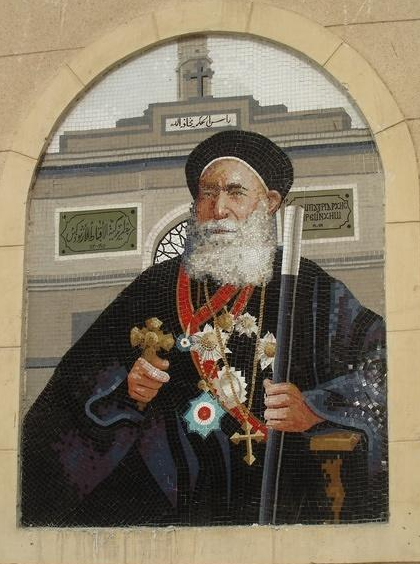
Pope Yoannis XII, the 93rd Patriarch




